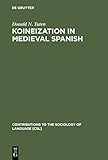Koineization in Medieval Spanish / Donald N. Tuten.
Material type: TextSeries: Contributions to the Sociology of Language [CSL] ; 88Publisher: Berlin ; Boston : De Gruyter Mouton, [2012]Copyright date: ©2003Edition: Reprint 2012Description: 1 online resource (345 p.) : 5 KtnContent type:
TextSeries: Contributions to the Sociology of Language [CSL] ; 88Publisher: Berlin ; Boston : De Gruyter Mouton, [2012]Copyright date: ©2003Edition: Reprint 2012Description: 1 online resource (345 p.) : 5 KtnContent type: - 9783110177442
- 9783110901269
- 467/.01 21
- PC4077 .T88 2003eb
- online - DeGruyter
- Issued also in print.
| Item type | Current library | Call number | URL | Status | Notes | Barcode | |
|---|---|---|---|---|---|---|---|
 eBook
eBook
|
Biblioteca "Angelicum" Pont. Univ. S.Tommaso d'Aquino Nuvola online | online - DeGruyter (Browse shelf(Opens below)) | Online access | Not for loan (Accesso limitato) | Accesso per gli utenti autorizzati / Access for authorized users | (dgr)9783110901269 |
Frontmatter -- Acknowledgements -- Contents -- Chapter 1. Introduction -- Chapter 2. Koines and koineization -- Chapter 3. The Burgos phase -- Chapter 4. The Toledo phase -- Chapter 5. The Seville phase -- Chapter 6. Conclusions -- Maps -- Notes -- References -- Index
restricted access online access with authorization star
http://purl.org/coar/access_right/c_16ec
How and why do changes happen when and where they do? Is it possible to explain changes that occurred centuries ago? These are the central questions addressed in this book, in which the author argues that the development of numerous features of medieval (and modern) Spanish can best be explained as the results of koineization, a process in which mixing among speakers of different dialects leads to the rapid formation of a new mixed and generally simplified variety. The book includes a complete introduction to koineization and detailed study of three stages of dialect mixing in medieval Spanish.
Issued also in print.
Mode of access: Internet via World Wide Web.
In English.
Description based on online resource; title from PDF title page (publisher's Web site, viewed 28. Feb 2023)


